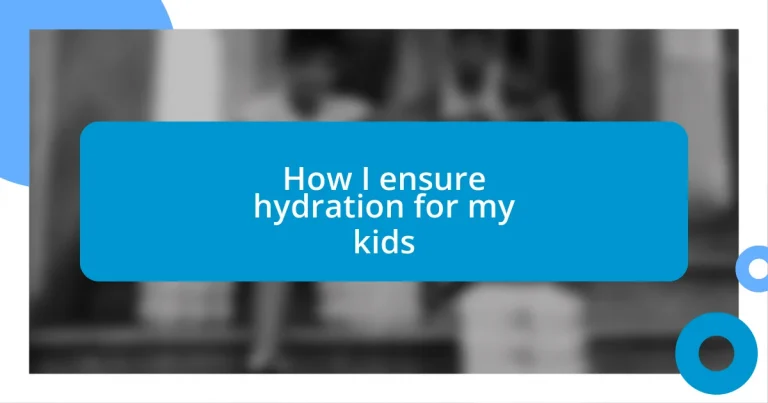Key takeaways:
- Children typically need 6 to 8 cups of fluids daily, with hydration needs varying based on activity and climate.
- Incorporating fun beverages like fruit-infused water and engaging kids in hydration challenges can make drinking water enjoyable.
- Recognizing signs of dehydration, such as lethargy or headaches, is essential for ensuring children’s well-being and encouraging proper hydration habits.
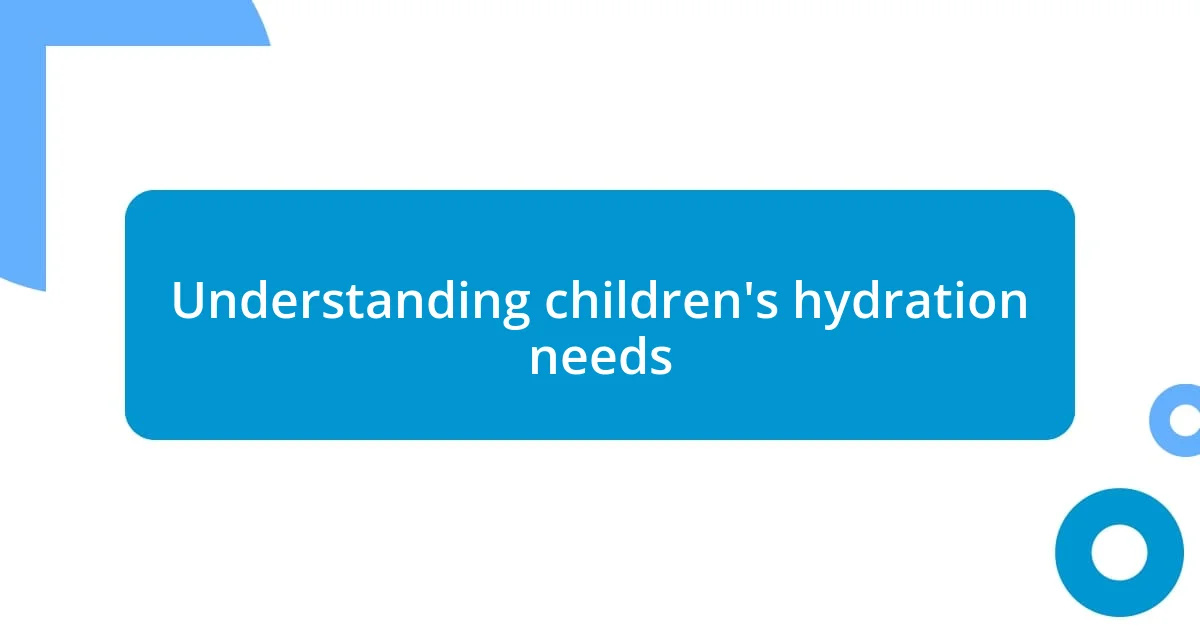
Understanding children’s hydration needs
Children’s hydration needs can be quite different from adults, and it’s important to understand why. Their little bodies are still developing, and they often overlook their thirst cues during play. Have you ever noticed how quickly kids can get lost in their fun, completely forgetting to drink water? I remember a time at the park when my daughter was so engrossed in climbing that she didn’t touch her water bottle for hours.
The general guideline is that children need about 6 to 8 cups of fluids a day, but this can vary based on activity level and climate. It’s astonishing how a warm day can increase the need for hydration dramatically. Just the other day, after a particularly hot afternoon of soccer practice, my son was so thirsty that he gulped down his water and said, “I didn’t even realize I needed that so much!” That moment really highlighted to me how easily kids can get caught up in the moment.
Moreover, hydration isn’t solely about water. Foods like fruits and vegetables contribute significantly to their daily intake. Have you ever tried making water-rich snacks like watermelon cubes or cucumber sticks? Incorporating these into their meals not only quenches their thirst but also makes hydration a fun and enjoyable routine. It’s these small changes that help me feel confident about keeping my kids well-hydrated.
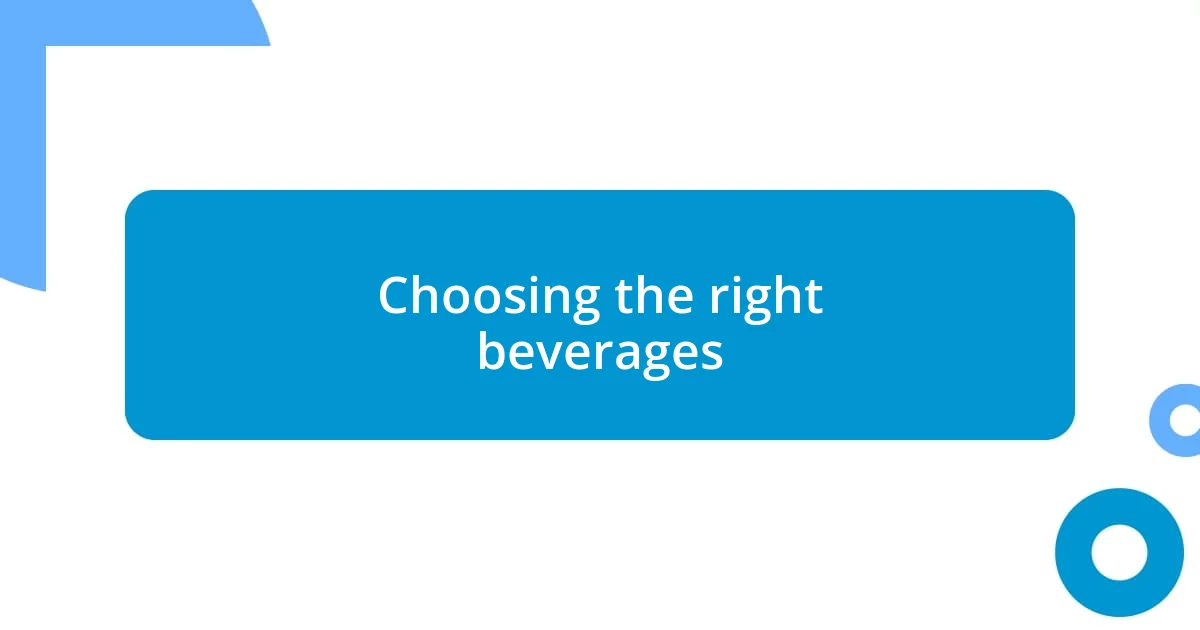
Choosing the right beverages
When it comes to choosing the right beverages for my kids, I find that variety is key. It’s easy for them to get bored with plain water, so I like to mix it up with fun and nutritious options. For instance, I often prepare homemade fruit-infused water. Seeing my kids pick out their favorite fruits for selection always brings a smile to my face. It’s amazing how a few slices of lemon or strawberries can transform plain water into something exciting!
Here are some beverages I regularly keep stocked to ensure my kids stay hydrated:
- Water: The ultimate hydrator—always on hand!
- Herbal teas: Caffeine-free options like chamomile or mint, served cold.
- Coconut water: A natural hydrator that kids tend to love.
- Milk: Provides hydration and essential nutrients.
- 100% fruit juices: In moderation, they can be refreshing and packed with vitamins.
Making hydration enjoyable has been a game-changer for us. The other day, my youngest exclaimed, “This is the best water ever!” while sipping on our watermelon-infused drink. If their favorites are aligned with good hydration, that’s a win in my book.
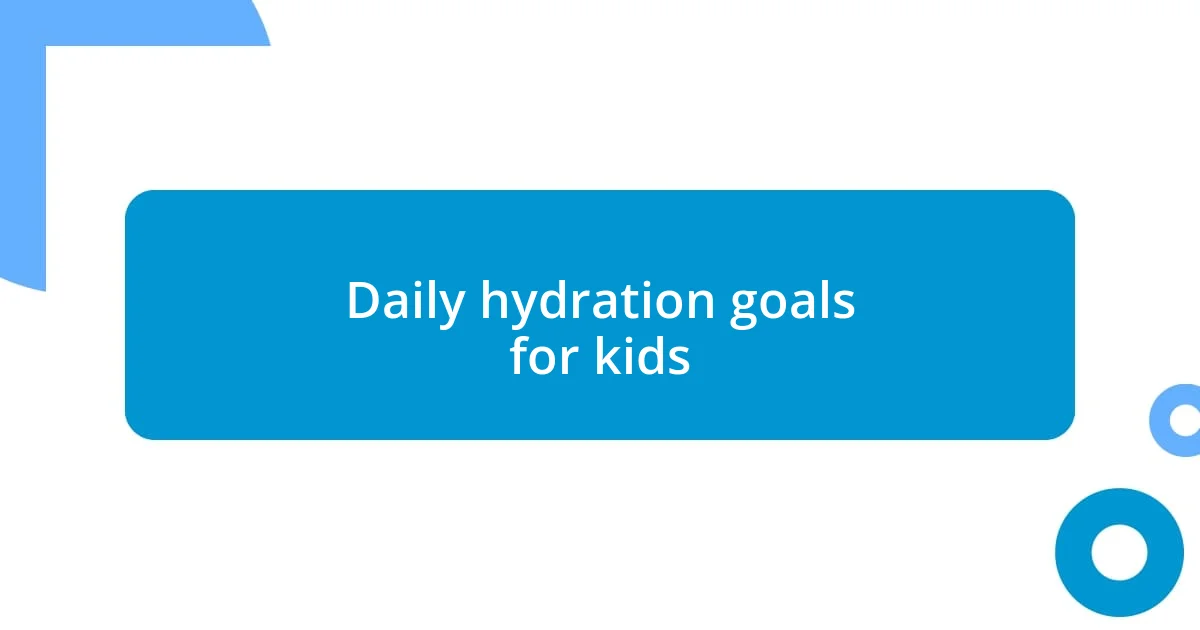
Daily hydration goals for kids
Understanding daily hydration goals for kids can be an eye-opener for many parents. From my perspective, the general recommendation is around 6 to 8 cups of fluids per day. However, I always consider my kids’ physical activities; a day filled with running around may require even more. For example, after a fun-filled trip to the zoo where they were constantly on their feet, I realized they consumed nearly double the usual amount of water. It’s moments like these that have taught me the importance of monitoring their hydration needs closely.
I also find it helpful to break down hydration needs by age, which can guide me in setting daily goals. For instance, younger kids typically need less than older children, so having a clear understanding of these benchmarks helps me feel more confident. When I created a hydration chart for my oldest son, he took on the challenge of hitting his daily goal with enthusiasm. Watching him tick off his hydration goals each day felt rewarding for both of us.
Now, as for practical applications, I love integrating hydration-focused habits into our daily routine. I often remind myself (and them) to take a sip of water at regular intervals, making it almost like a game. This adds a layer of fun while ensuring they meet their hydration targets. The satisfaction on their faces when they finish their water bottles can be reassuring, knowing I’m nurturing their healthy habits.
| Age Group | Daily Hydration Goal (Cups) |
|---|---|
| 1-3 years | 4 cups |
| 4-8 years | 5-7 cups |
| 9-13 years | 7-8 cups |
| 14-18 years | 8-11 cups |
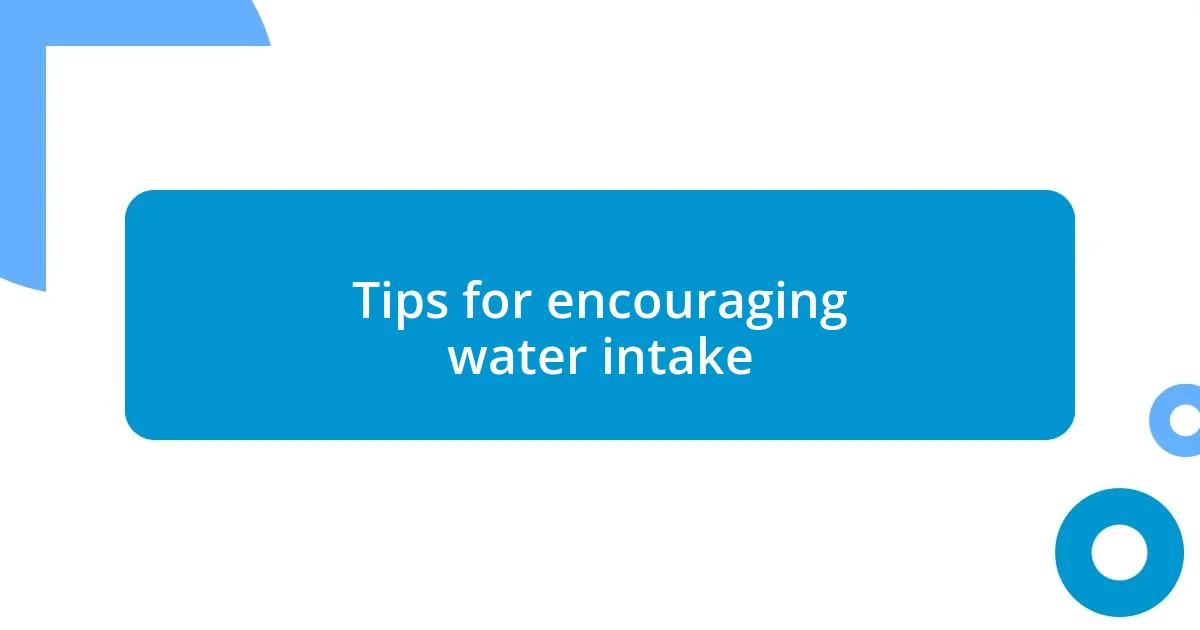
Tips for encouraging water intake
One of my favorite tricks for getting my kids to drink more water is to make it visually appealing. I remember one weekend, I filled clear bottles with colorful layers of fruit slices and ice cubes. They couldn’t resist reaching for those bottles, and I felt such joy watching them hydrate while savoring every sip. Isn’t it wonderful how a little color can spark interest and curiosity?
I’ve also found that my kids respond well to hydration challenges. For instance, I set up a friendly competition where we aim to finish our water bottles by lunch. The laughter and excitement that come with counting down the sips are just priceless! Plus, it’s a lovely bonding experience that reinforces the importance of staying hydrated together.
Another simple yet effective method has been creating a hydration schedule. We all get busy, and it’s easy to forget to drink enough, especially for kids engrossed in play. So, I set timers on my phone for regular intervals, prompting us all to take a quick sip. The catchy tune of my timer has become a family jingle, and it’s amusing how even my youngest mimics the tone when it’s time to hydrate! How can something so simple foster such joy in our day-to-day life?
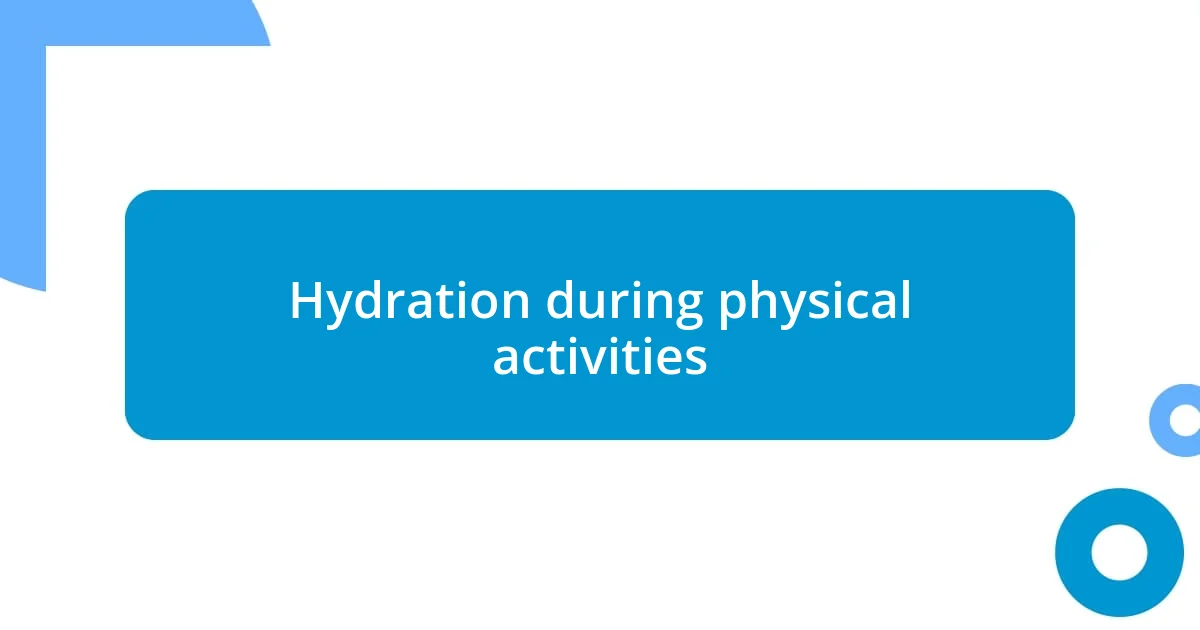
Hydration during physical activities
When my kids jump into a game of soccer or tag, I always keep an eye on their water intake. I’ve noticed that a quick water break not only refreshes them but also gives them a moment to catch their breath and refocus. One time during a particularly hot day at the park, I saw my youngest start to slow down. After a short drink, he came back to life, zipping around the playground like a new kid! It’s remarkable how hydration can reinvigorate them mid-activity.
I also think about the timing of hydration. I prefer to remind my kids to drink water before they even start playing. I remember a day when we took a family hike; the kids sipped water while we prepared. My daughter said it felt like a pre-game routine, which made it exciting! Starting the day with hydration not only encourages them to drink more but also sets a positive tone for physical activities.
Additionally, I’ve found engaging them in conversations about how they feel can make a difference. Asking things like, “Are you feeling thirsty, or do you feel energized?” allows them to connect their physical state with hydration. For instance, one afternoon after an intense dance session, my son mentioned feeling “a little fuzzy.” That was a telltale sign he needed a refill, and seeing him perk up after a good drink was a wonderful affirmation of listening to his body. How can we help our kids develop this awareness of hydration? By encouraging a dialogue about their feelings, it’s not just about the water; it’s about nurturing their understanding of their bodies’ needs.
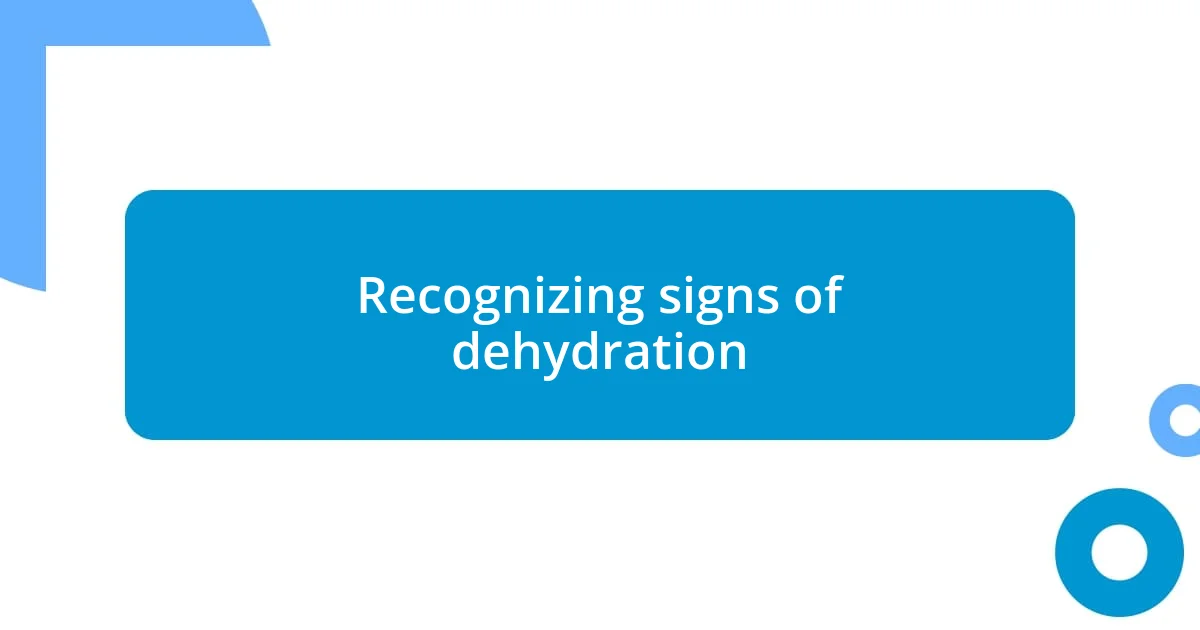
Recognizing signs of dehydration
Recognizing the signs of dehydration in my kids is crucial. There have been moments, like when we’re outside playing, and I catch my youngest rubbing his eyes or looking a bit lethargic. It’s funny how I can tell something’s off simply by observing his playful energy dwindle. If I see that, I know it’s hydration check time!
One afternoon, after swimming, my daughter complained of a headache. At first, I brushed it off, thinking she might just be tired, but then I remembered how important it is to connect headaches with hydration, especially in the sun. After a quick water break, her mood lifted, and her smile returned. How amazing is it that just a few sips can transform their day?
I also pay close attention when their lips start to chap or when they’re less chatty than usual. These can be subtle signs of dehydration that I’ve learned to recognize over time. I think about it like this: their bodies are sending me signals that it’s time to intervene. By understanding these signs, I feel empowered to step in and make sure they stay healthy and happy.












